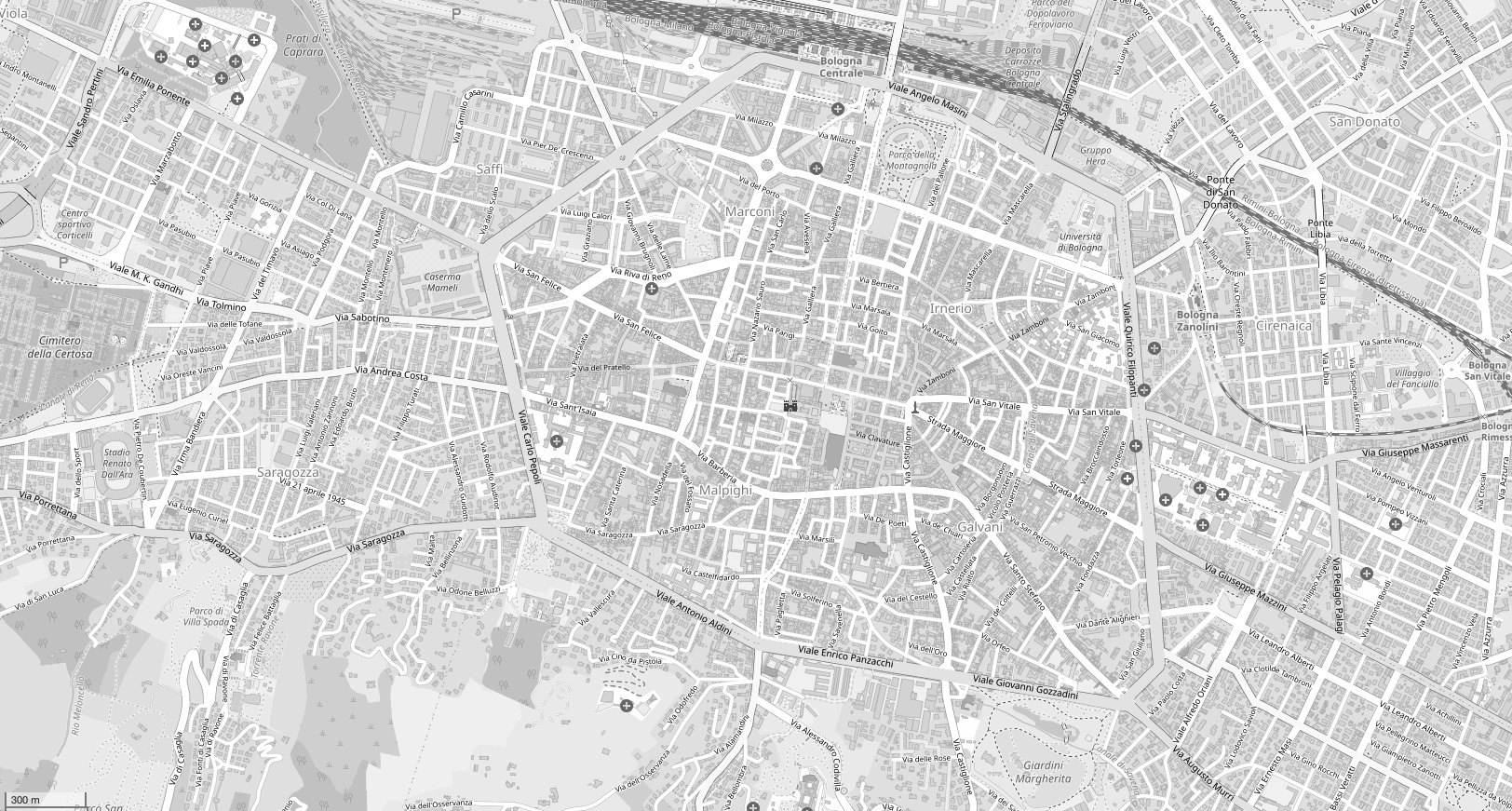Roaming the streets to visit Bologna’s public art and architecture is a great way to get to know the city.
The best meeting place and a great start is the Fontana del Nettuno (Fountain of Neptune) right under Bologna’s most important square – Piazza Maggiore. From there you may go in the direction of the Due Torri (Two Towers), Strada Maggiore or pop to Piazza Santo Stefano for an aperitivo (pre-dinner drink). If you’re in the mood for shopping, your high streets are via Indipendenza and via Rizzoli which form that T which turns pedestrian at the weekends and holidays.
This is also good preparation for those out-of-town visitors who inevitably show up wanting to see a Michelangelo. You’ll find some well-known chapels and cloisters, but also a number of alternative itineraries, such as ‘Bologna of Museums’, ‘Bologna of Poets’, and ‘Bologna, City of Music’, not to mention guided tours of the subterranean city, with its Roman ruins and little-known covered canals. The canals are visible from the street in only a few places, most notably in Via Piella, from a little window in the wall. There are also tours of the private courtyards, gardens and villas, again invisible from the street. Below are a few Bologna highlights not to be missed.

Basilica di San Domenico
Basilica San Martino Maggiore
Chiesa Santa Maria della Vita
Collegio di Spagna
Complesso di Santo Stefano
Palazzo dell'Archiginnasio
Santuario della Madonna di San Luca
© Image from OpenStreetMap modified by IWF Bologna
Basilica di San Domenico
Piazza San Domenico 13
The Basilica of San Domenico was erected by the Dominican friars as a place to store the remains of San Domenico di Guzman, founder of the Dominican Order. It is adorned with statues by Nicola Pisano, Nicolò dell’Arca and Michelangelo. You may recognize Michelangelo’s hand in the angel on the right, the one with the short Roman hair and powerful physique. There are also frescoes by Guido Reni, Filippino Lippi, Ludovico Carracci and other noted painters.
Basilica San Martino Maggiore
via Oberdan 25
Founded by the Carmelite Order in the 14th Century, the church has changed over time and now includes Gothic forms, Renaissance chapels, many precious frescoes and a 16th Century organ.
Chiesa Santa Maria della Vita
via Clavature 10
Here you will find Nicolò dell’Arca’s breathtaking terracotta sculpture Il Compianto Sul Cristo Morto (Lamentation over the Dead Christ). This dramatic depiction of sorrow and death was created around 1463 and consists of a group of life-sized figures, most prominently those of the Madonna and the three Marys, weeping over the dead body of Christ. For many, this is the most fascinating and unique piece of art in Bologna.

Collegio di Spagna
via Collegio di Spagna 4
Tel. 051.330408
Founded in 1365, this is one of Bologna’s most beautiful buildings. Open January to June for public visits by appointment. Call or send a fax to 051.5840508 to request a visit.
Complesso di Santo Stefano
via Santo Stefano 24
One of the symbols of the city at the centre of Bologna’s most beautiful square, this Benedictine foundation is also called Le Sette Chiese (The Seven Churches). The complex includes four Romanesque churches of the original seven, erected in different eras, and a beautiful cloister.
Palazzo dell’Archiginnasio
Piazza Galvani 1
Built in 1563 and used by the university until 1803, this building contains the beautiful, wood-paneled, anatomical theater once used in Bologna’s School of Medicine. Take note of the coats of arms that surround the courtyard and hallways, which describe the origin of the pupils who once studied here.
IN THE PROVINCE
There are also incredible collections open to the public outside Bologna, wonderful castles and villages perfect for day trips. To explore further and plan your trip, try consulting the emiliaromagnaturismo website at www.emiliaromagnaturismo.it. Here are just some suggestions for your outings:
Rocchetta Mattei
www.rocchetta-mattei.it
A marvellous treasure chest, which has been attracting visitors from all over the world and not just because of its aesthetics, but especially because of the extravagant Conte Cesare Mattei, its mysterious ‘elettromeopatia‘ medicine and the legends surrounding the place.
Dozza and its Walls
www.emiliaromagnaturismo.it/dozza
Listed among Italy’s most beautiful borghi (villages), this well-preserved medieval village enchants contemporary-art lovers too. In fact, it bears the traces of the ‘Biennale del muro dipinto‘, which every 2 years brings artists together for a colourful renovation of the facades of its narrow, cobbled streets.
Museo della Civiltà Contandina
Villa Smeraldi
via Sammarina 35
Localita’ San Marino, Bentivoglio
Tel. 051.891050
www.museociviltacontadina.bo.it
An impressive collection of everyday objects that describe the history of work, agricultural and artisan life of the pianura (flat land), displayed in a well-preserved villa.





